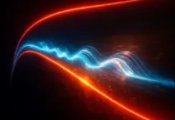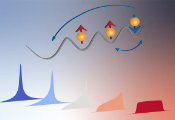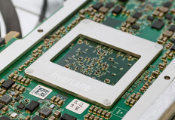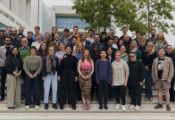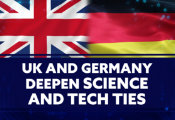Physicists Cool Quantum Simulator to Record-Breaking Low Temperatures
June 17 2025 -- Understanding and leveraging the incredible power of quantum materials could spark technological revolutions, such as superconductors that carry electricity with 100 percent efficiency at room temperature. Some of the most promising superconductors are ceramic materials called cuprates that are composed mostly of copper and oxygen. The catch is that scientists still don’t understand exactly how cuprates become superconductors, and the calculations to figure it out are too complicated for even the most powerful supercomputers.
But what if scientists didn’t need to rely exclusively on computing mathematical models to try to understand the workings of superconductivity and other quantum phenomena? What if they could physically simulate quantum systems and observe and experiment firsthand with model materials?
Now, thanks to a breakthrough in the lab of Harvard University’s Markus Greiner in collaboration with researchers at the Flatiron Institute’s Center for Computational Quantum Physics (CCQ), scientists will be able to do just that. In new research published in the journal Nature, the group describes how they cooled a system of electrically neutral atoms down to around one hundred billionth of room temperature, mimicking the behavior of electrons at extremely low temperatures. That breaks the previous record at just one-fifth of the coldest temperature ever reached for such a system.
The feat creates what Greiner calls “the most pristine artificial quantum system ever.” In so doing, the researchers have made it possible to simulate materials in ways that normal computers can’t. Paired with theory, the new experiments made possible by this groundbreaking lab work will bring about a new phase of understanding quantum systems.
“This work demonstrates how experiment and computation can be used in a highly synergistic way,” says study co-author Shiwei Zhang, a senior research scientist at the CCQ.
At the center of the new research is the Hubbard model, which describes the quantum mechanics of interacting electrons, the microscopic particles that give rise to the electrical and magnetic properties of quantum materials like superconductors. “We hope this will help usher in a new era in studying the Hubbard model and many other systems,” Zhang says.
A Major Breakthrough
On paper, the Hubbard model looks simple. It’s a checkerboard-like lattice of sites between which electrons can move. The model describes how electrons quantum mechanically tunnel between the lattice sites and how the electrons strongly interact with one another.
“Interacting electrons in quantum materials are delocalized; each electron is at many places at once,” he says. “Each also strongly feels the presence of the other electrons. This leads to a complexity that classical computers, even the most advanced supercomputers, have a very difficult time capturing. But it is exactly this ‘quantumness’ from which surprising and useful material properties like superconductivity emerge. That’s why we need a new methodology to solve and understand the Hubbard model.”
The idea behind the Greiner group’s research was to build a machine that could quantum mechanically — rather than classically — simulate the physics of the Hubbard model. In the absence of full-fledged quantum computers, which are still very much in development, the Harvard physicists sought to build a “quantum simulator” that could realize a wide range of Hubbard models. The lab’s collaborators at the CCQ, who are doing state-of-the-art numerical simulations on supercomputers, would then be able for the first time to compare those calculations with real-life experiments.
A breakthrough was needed to realize this goal, though: The team had to significantly lower the temperature in the quantum simulations — a goal that research groups worldwide have pursued over the last 10 years, initially without much success.
“Cuprate high-temperature superconductors become superconducting at about minus 170 degrees Celsius, or minus 250 degrees Fahrenheit,” Greiner explains. “Quantum simulations of the Hubbard model so far were not cold enough to reach those temperatures. Our new method enables a fivefold reduction in temperature, which makes it possible for the first time to simulate materials far below room temperature, where new physics is expected to occur, and simulations on classical computers become extremely difficult. This is a huge breakthrough that research groups worldwide have been working toward for nearly 20 years.”
Egg Carton Made of Lasers
In an ultra-high vacuum inside a glass chamber surrounded by powerful magnetic coils, the team cooled hundreds of lithium-6 atoms to nanokelvin temperatures — just hundreds of billionths of a degree above absolute zero. (Lithium-6 atoms, like electrons, are fermions. That allows the atoms to serve as a stand-in for how electrons behave.) Using programmable, ultra-precise lasers and digital micromirrors, the researchers trapped atoms in a grid of light called an optical lattice, a little like marbles in a 2D laser-made egg carton.
“The periodic modulation of the laser intensity forms a square optical lattice for the atoms to move and interact with each other, resembling electrons in a two-dimensional crystalline lattice,” says study lead author Muqing Xu, a postdoctoral fellow at Harvard. “The atoms in optical lattices realize the Hubbard model with virtual perfection.”
Xu says the team used quantum gas microscopy — a bit like a high-tech magnifying glass for atoms — to see individual atoms and control them with laser light. “Arbitrary laser intensity can be applied to individual atoms at will, just like projecting a movie onto a screen,” he says. “For measurement, we excite the atoms to emit photons. The fluorescence is collected by the objective onto a highly sensitive camera for us to see individual atoms at a lattice-site–resolved level.”
The new techniques enabled the researchers to change the shape of the grid without disturbing or adding heat to the system. This reshaping caused the atoms to squeeze together into a band insulator, a state where two atoms sit tightly in each spot of the grid, simultaneously pushing heat into a reservoir. Then the system was disconnected from the reservoir and expanded, locally splitting each spot into two. This splitting doubled the number of spots on the grid, allowing the atoms to spread out and making the system even cooler.
Successfully realizing this cooling method (originally suggested in a 2009 paper co-authored by CCQ Director Antoine Georges) was the experimental breakthrough that enabled the researchers to reach unprecedentedly low temperatures, opening the door to the study of exotic quantum physics.
CCQ research fellow Chunhan Feng and Zhang performed cutting-edge computations to confirm the laboratory results, using an approach they developed rooted in random sampling, called auxiliary-field quantum Monte Carlo. “Couple this new breakthrough with the recent progress from computation, where many advances have been achieved through algorithmic development and collaborations, with many such activities tied to CCQ, and we have some truly exciting prospects,” Zhang says.
A New Era
Greiner says the most important immediate impact of this new work is making quantum simulations truly useful for addressing open questions in materials science and condensed matter physics, where classical simulations are at their limit. “This is the start of a new era for quantum information technology,” he says.
On a more practical level, quantum simulations may facilitate the development of superconductors with higher transition temperatures — possibly as high as room temperature. The impact of those materials would be revolutionary. Imagine, for instance, superconducting power lines that could carry electricity across countries with no loss, enabling wind power from Cape Cod, Massachusetts, to charge iPhones in San Jose, California, or solar power from farms in the Arizona desert to charge electric cars in Michigan. And that’s only the beginning.
Greiner says that his team’s breakthrough opens up a completely new landscape of discovery. Now that Greiner’s team has created a low-temperature regime that had been inaccessible for decades, they are excited to investigate states of matter that emerge in the two-dimensional Hubbard model — for instance, d-wave superconductivity, where electrons pair up in a directional, wave-like pattern that may explain high-temperature superconductive materials. “With our new, programmable optical lattice, we will be able to explore a wide range of geometries beyond the ‘plain vanilla’ Hubbard model,” he says. “We look forward to mapping out uncharted landscapes in which entirely new quantum phases may emerge.”
Insights gleaned through the breakthrough experimental setup could impact transportation, computing and next-generation microwave electronics, Greiner says. Hubbard-type models “describe a wide range of potential quantum materials, opening the possibility to discover entirely new phenomena that could lead to functional materials with as yet unknown properties.”


